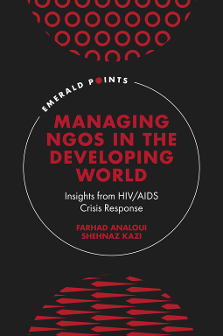Mahaba
, 10, 34–35, 43–44, 59–60
Maharashtra State AIDS Control Society (MSACS)
, 36–38
Management effectiveness
changing paradigm of NGO management, development and
, 31–32
of HIV/AIDS
, 23–24
Managerial effectiveness
, 1–3
contextual influences on
, 89–100
emerging model of
, 100–104
exploratory conceptual framework
, 9–11
generic model of parameters
, 10
and NGOs
, 5–8
research scope and challenges
, 9–11
Managerial effectiveness parameters
, 64–88
choices and opportunities of NGO managers
, 74–77, 80, 83
dominant managerial philosophy of NGO managers
, 85–89
influence of contextual factors on clusters of parameters
, 102
inter organisational influences for NGO managers
, 83–85
motivation of NGO managers
, 74–77
nature of interorganisational influences
, 86
organisational criteria of NGO managers
, 71–74
perception of NGO managers
, 64–68
skills and competencies of NGO managers
, 67–71
Millennium Development Goals
, 22
Multi-faceted
complexities
, 6–7
influencing factors
, 28–29
personal attributes and qualities
, 91–92
